Meet the Ragamuffin the cat that’s as sweet as its name suggests! With its large, affectionate personality and fluffy, luxurious coat, this breed is a true cuddle magnet. Often mistaken for its close cousin, the Ragdoll, the Ragamuffin carved out its own identity in 1994.
Now, it stands proudly as a unique breed known for its loving nature and striking good looks. Ready to discover everything about this charming feline? From their playful personality to their size, colors, and lifespan, we’ve got you covered in the ultimate Ragamuffin guide by Nexus Pets!
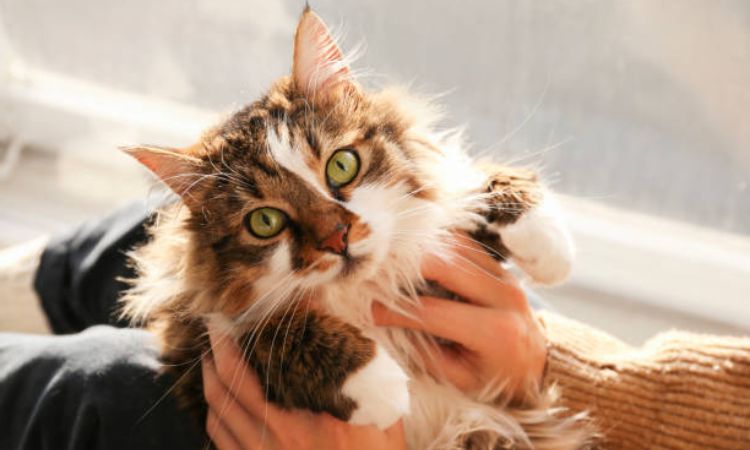
Ragamuffin Cat Price
Ragamuffin kittens are considered a premium breed due to their affectionate nature, unique appearance, and relatively small population. On average, purchasing a Ragamuffin kitten from a reputable breeder can cost between $1,200 and $2,000, though prices may vary depending on several factors.
Factors Influencing Price
- Breeder Reputation: Established breeders with a strong track record of healthy, well-socialized kittens often charge more. They also provide health guarantees, proper documentation, and guidance on care.
- Pedigree and Lineage: Kittens from champion bloodlines or award-winning parents can fetch higher prices. A well-documented pedigree may appeal to owners interested in showing or breeding.
- Location: Prices can differ based on geographic region. Kittens in major cities or regions with high demand often cost more than those in less populated areas.
Additional Costs to Consider
Buying a Ragamuffin kitten is just the beginning of your investment. Pet parents should also account for routine and one-time expenses, including:
- Veterinary Care: Initial vet checkups, vaccinations, and regular wellness visits.
- Spaying/Neutering: Most reputable breeders require kittens to be spayed or neutered before leaving for new homes, which can add to the cost if not included.
- Supplies: Food, litter, toys, scratching posts, bedding, and grooming tools.
Adoption Options and Costs
For those looking for a more budget-friendly option, adopting a Ragamuffin from a shelter or rescue may be possible. Adoption fees are generally lower, ranging from $200 to $600, and often include spaying/neutering, vaccinations, and a basic health check. While adopting can be more affordable, availability is limited due to the breed’s rarity.
Ragamuffin Cat Personality
Ragamuffins are often described as “the perfect family cat” thanks to their sweet, loving, and easygoing personalities. They are the ultimate cuddle buddies, forming deep bonds with their humans and expressing their affection in the most endearing ways. Let’s take a closer look at what makes the Ragamuffin cat’s personality truly special.
Gentle and Affectionate
Ragamuffins are known for their docile nature. They thrive on human companionship and will follow you from room to room, eager to be near you. Whether you’re relaxing on the couch, working, or even cleaning, your Ragamuffin will be right there by your side, often curling up in your lap for a cozy nap. They love attention and often express affection by purring, nuzzling, and even “hugging” their owners with their large paws.
Friendly and Social
These cats are incredibly sociable and get along with nearly everyone—including children, other pets, and even strangers. They’re not territorial or aggressive and will often approach new people with curiosity and a calm demeanor. If you’re hosting a gathering, don’t be surprised if your Ragamuffin is the life of the party, moving from one guest to another, looking for a new lap to claim.
Playful and Fun-Loving
Though Ragamuffins are laid-back, they’re also playful. They enjoy interactive games like fetch, chasing after toys, or simply batting at strings and laser pointers. They’re not as energetic or athletic as some breeds, but they have bursts of playful energy and enjoy being active with their human family members. Many Ragamuffins also enjoy going for walks on a leash, which is an unexpected but delightful trait for those who want a more dog-like cat.
Easy to Train
Because of their strong desire to please, Ragamuffins are quick learners. They can easily pick up basic tricks, such as sitting or giving high fives, and some may even learn how to fetch small toys. Training is often made even easier by their food motivation—they’re known to be food-driven, so training sessions are a great bonding experience. Plus, their laid-back nature means they don’t get frustrated easily, making them great for first-time cat owners or families with young children.
Not a “Solo” Cat
Ragamuffins are definitely not independent cats. They don’t do well being left alone for long periods, as they crave social interaction. They thrive in households where there’s always someone around to give them attention. If you’re often away, it might be worth considering a pet sitter or another animal companion to keep them company.
Calm and Relaxed
One of the most cherished aspects of the Ragamuffin personality is their calmness. They are not easily stressed or anxious, making them great for homes with hectic schedules or noisy environments. If you have a busy family, a Ragamuffin will happily adapt to your lifestyle, finding quiet corners to relax and observing the action from the sidelines.
A Genuine Lap Cat
If you’ve ever dreamed of a lap cat, the Ragamuffin is the perfect choice. They’re known for being incredibly affectionate, and they love nothing more than curling up with their owners. Their loving nature makes them fantastic companions for watching TV, reading a book, or simply unwinding after a long day. Whether it’s sitting on your lap or snuggling by your side, the Ragamuffin’s devotion is hard to beat.
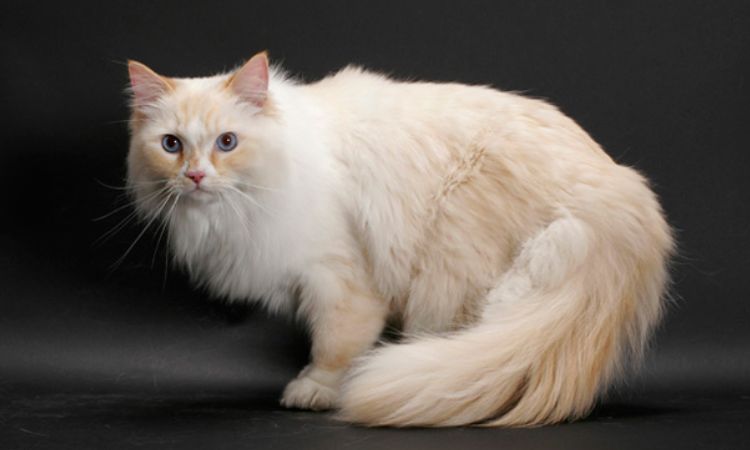
Ragamuffin Cat Size and Appearance
Ragamuffin cats are one of the largest and most striking domestic cat breeds, combining a robust, muscular frame with a soft, plush coat. Their appearance and size make them instantly recognizable and beloved among cat enthusiasts.
Average Weight and Height
Ragamuffins are larger than many other domestic breeds, with males typically outweighing females:
- Male Ragamuffins: 15–20 pounds (6.8–9.0 kg)
- Female Ragamuffins: 10–15 pounds (4.5–6.8 kg)
Height at the shoulder generally ranges from 9 to 11 inches, giving them a solid, powerful presence while maintaining graceful proportions.
Physical Characteristics
- Body Shape: Ragamuffins have a rectangular, muscular body with a broad chest and strong limbs. They are both sturdy and elegant, with a long, well-proportioned torso.
- Head and Face: Their round, broad head features full cheeks, a strong chin, and moderately tufted ears, giving them a gentle, sweet expression.
- Eyes: One of their most captivating traits is their large, walnut-shaped eyes, which can come in blue, green, gold, or amber, creating an expressive and almost human-like gaze.
- Coat Texture: Ragamuffins have a semi-long, silky, and plush coat that is surprisingly tangle-resistant. Their fur often features a ruff around the neck, a plumed tail, and tufts between the toes. The breed comes in all colors and patterns, unlike the more color-restricted Ragdoll.
Differences from Related Breeds (Ragdoll)
- Coat Variety: Ragamuffins boast a wider range of colors and patterns compared to Ragdolls, whose coats are primarily pointed.
- Size and Build: Ragamuffins are typically heavier and slightly more muscular than Ragdolls.
- Facial Features: Ragamuffins have rounder heads and walnut-shaped eyes, whereas Ragdolls have a more triangular face with almond-shaped eyes.
- Personality Differences: While both breeds are affectionate, Ragamuffins tend to be slightly more playful and social, whereas Ragdolls are generally more laid-back.
Growth Stages
- Kitten (0–6 months): Ragamuffin kittens are born white and gradually develop their full coat color and patterns. They grow rapidly, reaching 3.5–6 pounds (1.5–2.7 kg) by six months.
- Adolescent (6–12 months): Muscle development and size increase, with kittens showing the beginning of their rectangular build. By the end of the first year, most weigh 7–10 pounds (3.2–4.5 kg).
- Adult (1–4 years): Ragamuffins reach their full size around four years, with males weighing 15–20 pounds and females 10–15 pounds. Their coat reaches full density and length.
- Mature (4+ years): Fully grown, Ragamuffins maintain their muscular frame, plush coat, and affectionate personality, with grooming needs remaining moderate.
Ragamuffins are large, muscular cats with a rectangular body, broad chest, and soft, semi-long coat. Their expressive walnut-shaped eyes, rounded head, and plush fur make them exceptionally charming. Combined with their affectionate, playful nature, Ragamuffins are ideal for families or individuals seeking a gentle, loyal, and visually striking companion.
Ragamuffin Cat Colors and Patterns
Core Colors of Ragamuffins
Ragamuffins come in a broad spectrum of colors, ranging from classic dark hues to soft, diluted shades. Below are the most common core colors:
- Black
A deep, rich color that gives Ragamuffins a sleek and sophisticated appearance. - Blue (Diluted Black)
The diluted form of black, giving the coat a soft, slate-blue hue. - Chocolate
A warm, medium-brown color, often seen in solid-colored Ragamuffins or tabby patterns. - Lilac (Diluted Chocolate)
A soft, pale lavender color, achieved by diluting chocolate. - Red (Orange)
A vibrant, warm orange, frequently seen in solid-colored cats or those with tabby patterns. - Cream (Diluted Red)
A softer, paler version of red, giving a very light and creamy appearance. - White
Pure white coats are common in Ragamuffins and can be found in solid colorations or mixed with other patterns. - Brown
A deep, earthy brown, which can appear in both solid or tabby patterns. - Fawn
A soft, beige-like color, typically seen as a diluted version of brown.
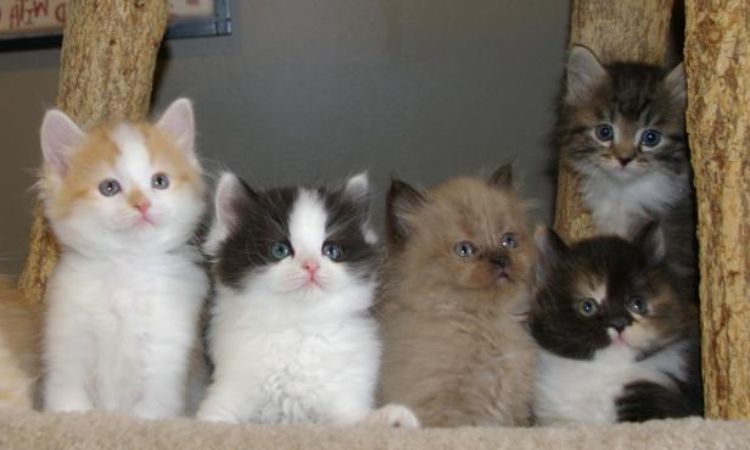
Common Coat Patterns in Ragamuffins
Ragamuffins can have a variety of distinct patterns, ranging from simple solids to intricate tabby designs. Let’s explore some of the most common and beloved patterns:
- Solid Coat
A solid coat features a uniform color across the entire body. These cats often have small white patches on the feet, tail, or chin, adding a slight contrast to the solid hue. Common solid colors include black, red, and cream. - Tortoiseshell
Tortoiseshell Ragamuffins feature a blended pattern of black and red. These cats do not typically have any white patches, and the pattern has a marbled effect that can be chaotic but beautiful. This pattern is mostly found in females due to genetics. - Tabby
Tabby patterns are a staple in Ragamuffins, and there are several subtypes:- Classic Tabby: Features swirled patterns on the body, creating a marble-like look.
- Mackerel Tabby: Characterized by thin, parallel striped lines running down the sides.
- Spotted Tabby: The body is covered in random spots instead of stripes.
- Ticked Tabby: A subtle pattern where the individual hairs are banded with multiple colors, giving the fur a salt-and-pepper effect.
- Bi-Color
A bi-color coat features two distinct colors: one solid color (like black, red, or blue) and white. The white typically appears on the chest, belly, paws, and face. Some bi-color Ragamuffins have “saddle” markings, where the color forms a large patch along the back, while others have smaller patches. - Tuxedo
A subtype of the bi-color pattern, the tuxedo Ragamuffin resembles a formal outfit, usually in black with white markings on the chest, paws, and face. These cats look as though they’re dressed for a classy event! - Mink
Mink is a very distinctive pattern seen only in the Ragamuffin breed. It features a glossy coat with a subtle contrast between the body and extremities. The result is a smooth, shiny look that’s unlike any other coat type. Mink coats are typically softer and finer than other Ragamuffin coats.
Less Common Patterns
While the above patterns are the most prevalent in Ragamuffins, there are also a few rarer ones that are still cherished by cat enthusiasts.
- Calico
Calico cats have a three-color pattern—typically black, red, and white—arranged in random patches. It is extremely rare for a male calico to exist, as this requires an unusual genetic mutation. Most calicos are female. - Colorpoint
The colorpoint pattern is rare in Ragamuffins and more common in Ragdolls. Cats with this pattern have light bodies with darker extremities (ears, tail, paws, and face). It’s a beautiful, striking look but is not recognized in the Ragamuffin breed standard.
Development of Colors
A fascinating trait of Ragamuffins is that their kittens are born completely white, regardless of what color they will eventually become. As they grow, their coats develop, and their true colors and patterns emerge gradually over time—this process can take several months.
Ragamuffin Cat Lifespan and Health
Average Lifespan and Factors Affecting Longevity
The average lifespan of a Ragamuffin cat typically ranges between 15 to 17 years, though many may live well into their late teens or even early twenties with proper care. The breed is generally healthy, and factors such as genetics, diet, exercise, and veterinary care all play an essential role in determining how long your Ragamuffin will live.
Several factors can impact the lifespan of your Ragamuffin:
- Genetics: The genetic makeup of your cat can influence its overall health and life expectancy. Some Ragamuffins may be predisposed to certain conditions due to their genetic background, so being aware of their lineage and having access to genetic testing can help monitor and prevent potential health issues.
- Diet and Nutrition: A balanced, high-quality diet is one of the most important factors in supporting the longevity of your Ragamuffin. A well-balanced diet can help maintain a healthy weight, promote good organ function, and improve overall quality of life.
- Exercise: While Ragamuffins aren’t as active as some breeds, they still need regular play and interaction. Keeping them at a healthy weight and providing opportunities for mental and physical stimulation will contribute to their well-being and help prevent obesity-related issues.
- Preventive Health Care: Routine preventive care, including vaccinations, flea control, and regular check-ups, is essential for keeping your Ragamuffin healthy.
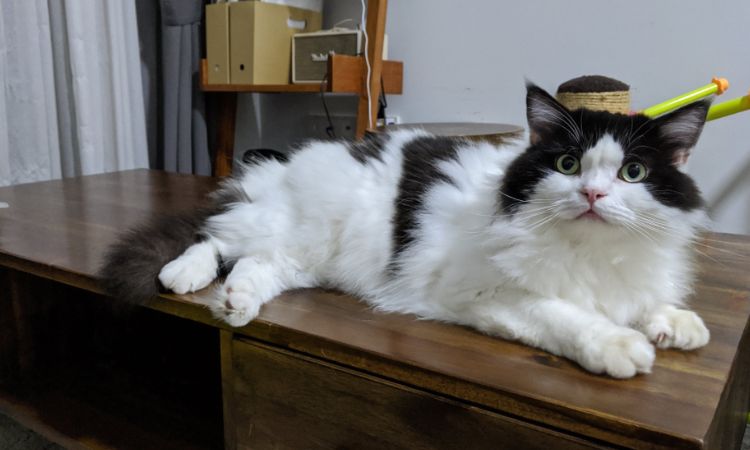
Common Health Issues or Genetic Conditions to Watch For
While Ragamuffins are generally healthy, they may be prone to a few hereditary conditions and other health concerns common in larger cat breeds.
1. Hypertrophic Cardiomyopathy (HCM)
Hypertrophic cardiomyopathy is a genetic heart disease that causes the heart muscles to thicken and the heart to become less efficient at pumping blood. Ragamuffins can be affected by this condition, typically showing signs between the ages of 1 to 2 years. Symptoms may include lethargy, difficulty breathing, and reduced appetite. Fortunately, genetic testing can identify carriers of the disease, and it is advisable to avoid breeding cats with the condition.
2. Arthritis
As with other larger breeds, arthritis can become an issue as Ragamuffins age, particularly around 10 years old or older. Their larger frame makes them more susceptible to joint problems. Keeping your Ragamuffin at an ideal weight and providing joint supplements or pain management can help delay or minimize the effects of arthritis. If you notice any changes in your cat’s mobility or difficulty grooming, it may indicate arthritis.
3. Dental Problems
Like many other cats, Ragamuffins can develop dental disease if proper care isn’t taken. Regular tooth brushing and check-ups with a vet can help prevent tartar buildup, gum disease, and other dental issues.
4. Obesity
Ragamuffins are prone to becoming overweight if they are overfed or don’t get enough exercise. Obesity can lead to a variety of other health problems, including diabetes, heart disease, and joint issues. Keeping track of your Ragamuffin’s weight and adjusting their diet and exercise routine as needed can help prevent this.
Recommended Preventive Care and Diet Tips
To ensure the health and longevity of your Ragamuffin, here are some preventive care tips and diet recommendations:
1. Nutrition and Diet
- High-Quality Protein: Feed your Ragamuffin a balanced diet that includes high-quality animal protein as the primary ingredient. Cats are obligate carnivores, so protein is essential for their overall health.
- Portion Control: Overfeeding can lead to obesity, which can cause a range of health problems. Measure out your cat’s food and be mindful of treats, keeping them under 10% of their daily caloric intake.
- Transitioning Food: Ragamuffins are slow to mature, so it may be necessary to switch from kitten food to adult food later than in other breeds. Consult your vet for the best time to make this change.
- Supplements: If your Ragamuffin is prone to joint issues or has dry skin, consult your vet about adding supplements like glucosamine or omega-3 fatty acids to their diet.
2. Regular Exercise
Though Ragamuffins are not the most energetic breed, they still need regular playtime and opportunities for mental stimulation. Use interactive toys, wands, or puzzle feeders to keep them engaged. Daily play sessions will help maintain a healthy weight and promote overall well-being.
3. Grooming
Ragamuffins have medium-length, silky coats that require regular grooming. Brush them weekly to prevent tangles, especially around the belly and underarms. Grooming is also an opportunity to check for skin issues, fleas, or lumps.
4. Regular Veterinary Check-ups
Routine check-ups with a vet are essential for monitoring your Ragamuffin’s health. Annual vet visits for vaccinations, blood tests, and physical examinations will help detect any early signs of health problems. It’s especially important for Ragamuffins to have their heart health monitored through routine check-ups due to their predisposition to hypertrophic cardiomyopathy.
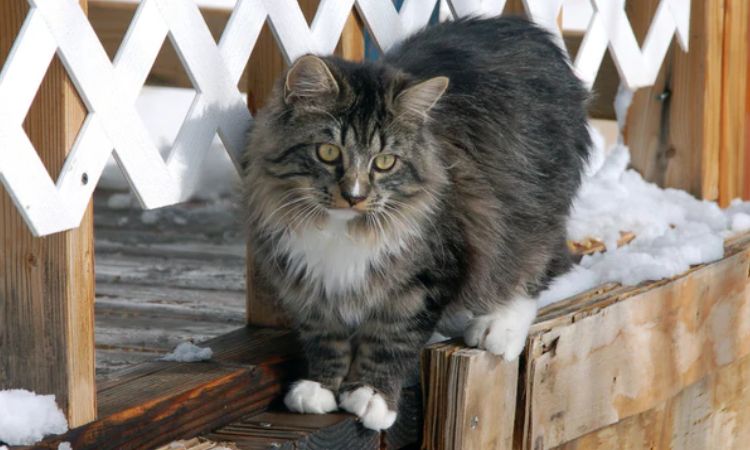
Importance of Regular Veterinary Check-ups
Routine veterinary visits are crucial for maintaining the health and longevity of your Ragamuffin. Regular exams help catch potential issues early before they become serious, saving you both time and money in the long run. Here’s why they’re so important:
- Early Detection of Health Issues: Conditions like hypertrophic cardiomyopathy, arthritis, or dental disease can be harder to detect at home but are more easily spotted by your vet during regular check-ups.
- Vaccinations and Parasite Control: Regular visits ensure that your Ragamuffin stays up to date on vaccinations and parasite prevention, reducing the risk of illnesses and infections.
- Routine Blood Work: As your Ragamuffin ages, regular blood tests will help keep track of their kidney, liver, and thyroid health, ensuring any issues are caught early.
- Behavioral and Dietary Advice: Your vet can offer guidance on managing your Ragamuffin’s weight, dietary needs, and any behavioral issues.
Ragamuffins are generally a healthy and long-lived breed, with an average lifespan of 15–17 years. By providing them with a balanced diet, regular exercise, and regular veterinary care, you can help ensure that your Ragamuffin enjoys a long, happy life. Stay vigilant for any signs of health issues such as heart disease or arthritis, and don’t hesitate to seek veterinary advice when necessary. With proper care, your Ragamuffin can thrive for many years as a beloved and affectionate member of your family.






